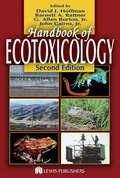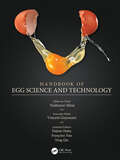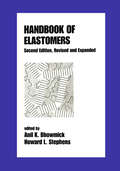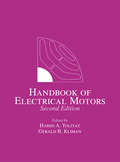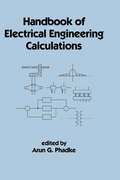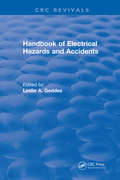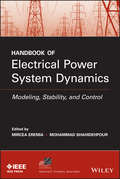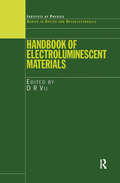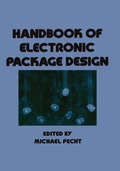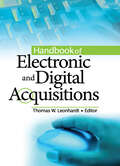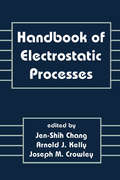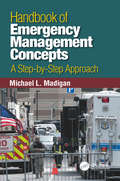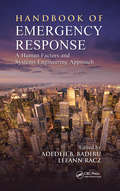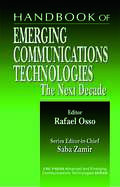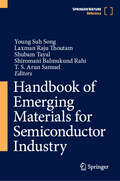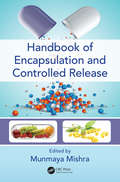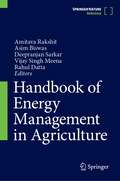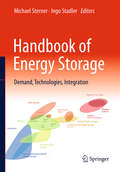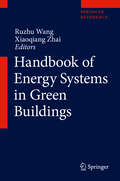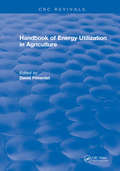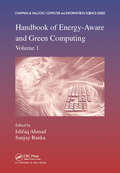- Table View
- List View
Handbook of Ecosystem Theories and Management
by F. Müller S. E. JørgensenAs part of the Environmental and Ecological Modeling Handbooks series, the Handbook of Ecosystem Theories and Management provides a comprehensive overview of ecosystem theory and the tools - ecological engineering, ecological modeling, ecotoxicology and ecological economics -to manage these systems. The book is laid out to provide a summary or
Handbook of Ecotoxicology
by John Cairns Barnett A. Rattner David J. Hoffman G. Allen BurtonCompletely revised and updated with 18 new chapters, this second edition includes contributions from over 75 international experts. Also, a Technical Review Board reviewed all manuscripts for accuracy and currency. Focusing on toxic substance and how they affect the ecosystems worldwide, the book presents methods for quantifying and measuring ecotoxicological effects in the field and in the lab, as well as methods for estimating, predicting, and modeling in ecotoxicology studies. This is the definitive reference for students, researchers, consultants, and other professionals in the environmental sciences, toxicology, chemistry, biology, and ecology - in academia, industry, and government.
Handbook of Egg Science and Technology
by Yoshinori Mine Hajime Hatta Vincent Guyonnet Françoise Nau Ning QiuEggs are one of the most popular foods worldwide due to their great taste and versatility, economical value and high nutritional content. The egg plays an important role in the human diet, both for the nutritional value of its many components (e.g., proteins, vitamins, minerals, choline, specific long chain fatty acids) as well for its wide range of functional characteristics, including foaming, gelling and emulsifying properties. The egg sector is a vibrant field with many new developments in terms of production, processing and commercialization as well as research. Since the beginning of the 21st century, the global production of eggs has grown by 69.5%, farm production systems have evolved to improve the welfare of laying hens, many eggshell and egg products have been developed to address the changing demands of consumers and our knowledge of the composition of the egg has been boosted by the latest gene-based technologies. Information on the science and technology of egg and egg processing is essential to governments, academia and industry. The Handbook of Egg Science and Technology aims to be the first book providing a complete source of information about egg science and technology, covering topics such as world egg production, marketing of eggs, chemistry of egg components, functional properties of egg components, egg processing, egg product development, eggshell quality, grading, egg microbiology, egg pasteurization, egg nutrition and bioactive components, egg biotechnology and sustainability of egg production. Features Includes the most current and comprehensive scientific and technical information about egg science and technology Presents an ideal guide for professionals in related food industries, egg business consultants, regulatory agencies and research groups Answers the need for a comprehensive textbook for upper-level undergraduate and graduate courses in food science, animal science and poultry departments A global panel of experts in the field of egg science was gathered with the aim to provide the most updated information and development on many topics likely to interest readers ranging from academia and food science students to managers working in the food production and egg processing sectors. This handbook is an excellent resource for the food and poultry industry, R&D sectors, as well as experts in the field of food and nutrition.
Handbook of Elastomers (Plastics Engineering)
by Anil K. Bhowmick Howard L. StephensProvides the latest authoritative research on the developments, technology, and applications of rubbery materials. Presents structures, manufacturing techniques, and processing details for natural and synthetic rubbers, rubber-blends, rubber composites, and thermoplastic elastomers. 80% revised and rewritten material covers major advances since publication of the previous edition.
Handbook of Electric Motors
by Hamid A. Toliyat Gerald B. KlimanPresenting current issues in electric motor design, installation, application, and performance, this second edition serves as the most authoritative and reliable guide to electric motor utilization and assessment in the commercial and industrial sectors. Covering topics ranging from motor energy and efficiency to computer-aided design and equipment selection, this reference assists professionals in all aspects of electric motor maintenance, repair, and optimization. It has been expanded by more than 40 percent to explore the most influential technologies in the field including electronic controls, superconducting generators, recent analytical tools, new computing capabilities, and special purpose motors.
Handbook of Electrical Engineering Calculations (Electrical and Computer Engineering #Vol. 106)
by Arun G. PhadkeWritten by experienced teachers and recognized experts in electrical engineering, Handbook of Electrical Engineering Calculations identifies and solves the seminal problems with numerical techniques for the principal branches of the field -- electric power, electromagnetic fields, signal analysis, communication systems, control systems, and computer engineering. It covers electric power engineering, electromagnetics, algorithms used in signal analysis, communication systems, algorithms used in control systems, and computer engineering. Illustrated with detailed equations, helpful drawings, and easy-to-understand tables, the book serves as a practical, on-the-job reference.
Handbook of Electrical Hazards and Accidents
by Leslie A. GeddesThis book is written mainly for attorneys, physicians, and investigators who are concerned with accidents associated with electric current. It is based on approximately 50 years of personal research, augmented by experience in teaching medical and biomedical engineering students and as an expert witness in litigation involving electrical injury. The material is presented in two ways: non-technically, for attorneys and physicians, and technically, for their expert witnesses and engineers. Since there is no typical electrical accident, the accidents described and the material presented in the chapters are selected to aid the reader in explaining the cause of any particular electrical accident.
Handbook of Electrical Power System Dynamics: Modeling, Stability, and Control (IEEE Press Series on Power Engineering #92)
by Mohammad Shahidehpour Mircea EremiaThis book aims to provide insights on new trends in power systems operation and control and to present, in detail, analysis methods of the power system behavior (mainly its dynamics) as well as the mathematical models for the main components of power plants and the control systems implemented in dispatch centers. Particularly, evaluation methods for rotor angle stability and voltage stability as well as control mechanism of the frequency and voltage are described. Illustrative examples and graphical representations help readers across many disciplines acquire ample knowledge on the respective subjects.
Handbook of Electroluminescent Materials (Series in Optics and Optoelectronics)
by D. R. VijAn electroluminescent (EL) material is one that emits electromagnetic (EM) radiation in the visible or near visible range when an electric field is applied to it. EL materials have a vast array of applications in the illumination and displays industries, from cheap and energy efficient lighting to large high resolution flat panel displays.
Handbook of Electronic Package Design (Mechanical Engineering #76)
by Michael PechtBoth a handbook for practitioners and a text for use in teaching electronic packaging concepts, guidelines, and techniques. The treatment begins with an overview of the electronics design process and proceeds to examine the levels of electronic packaging and the fundamental issues in the development
Handbook of Electronic and Digital Acquisitions
by Thomas W LeonhardtEverything you need to know about adding e-resources to your library's servicesHandbook of Electronic and Digital Acquisitions steers librarians through the process of evaluating, choosing, and managing electronic resources as they expand their collection development policies to include electronic databases. This handy, how-to guide takes a practic
Handbook of Electroporation
by Damijan MiklavčičThis major reference work is a one-shot knowledge base on electroporation and the use of pulsed electric fields of high intensity and their use in biology, medicine, biotechnology, and food and environmental technologies. The Handbook offers a widespread and well-structured compilation of 156 chapters ranging from the foundations to applications in industry and hospital. It is edited and written by most prominent researchers in the field. With regular updates and growing in its volume it is suitable for academic readers and researchers regardless of their disciplinary expertise, and will also be accessible to students and serious general readers. The Handbook's 276 authors have established scholarly credentials and come from a wide range of disciplines. This is crucially important in a highly interdisciplinary field of electroporation and the use of pulsed electric fields of high intensity and its applications in different fields from medicine, biology, food processing, agriculture, process engineering, energy and environment. An Editorial Board of distinguished scholars from across the world has selected and reviewed the various chapters to ensure the highest quality of this Handbook.The book was edited by an international team of Section Editors: P. Thomas Vernier, Boris Rubinsky, Juergen Kolb, Damijan Miklavcic, Marie-Pierre Rols, Javier Raso, Richard Heller, Gregor Serša, Dietrich Knorr, and Eugene Vorobiev.
Handbook of Electrostatic Processes
by Jen-Shih Chang Arnold J. Kelly Joseph M. Crowley"Provides detailed, comprehensive descriptions of electrostatic processes as well as their applications in areas such as rheology, atomization and spraying, industrial dust particle precipitation and filtering, biomedical engineering, gas treatments, atmospheric electricity, chemical reactors, and electronic devices. Summarizes electrostatic fundamentals and electrical phenomena in solids and fluids."
Handbook of Emergency Management Concepts: A Step-by-Step Approach
by Michael L. MadiganThis book provides a step-by-step process that focuses on how to develop, practice, and maintain emergency plans that reflect what must be done before, during, and after a disaster, in order to protect people and property. The communities who preplan and mitigate prior to any incident will be better prepared for emergency scenarios. This book will assist those with the tools to address all phases of emergency management. It covers everything from the social and environmental processes that generate hazards, to vulnerability analysis, hazard mitigation, emergency response, and disaster recovery.
Handbook of Emergency Response: A Human Factors and Systems Engineering Approach (Environmental and Occupational Health Series #27)
by Adedeji B. Badiru Leeann RaczDespite preemptive preparations, disasters can and do occur. Whether natural disasters, catastrophic accidents, or terrorist attacks, the risk cannot be completely eliminated. A carefully prepared response is your best defense. Handbook of Emergency Response: A Human Factors and Systems Engineering Approach presents practical advice and guidelines
Handbook of Emerging Communications Technologies: The Next Decade (Advanced & Emerging Communications Technologies)
by Rafael OssoCommunication technologies change the way we live our lives-the ways we communicate and share information, the news, and our entertainment. The new millennium promises to bring some of the most volatile activity in the history of communications, as we continue to be bombarded by new standards and technologies. The near frenzy of corporate mergers and acquisitions accelerates technological development and can provide hints of what is to come. With the rapid appearance of new protocols, standards, and tools, it becomes increasingly difficult -and increasingly important-for communications professionals to remain up-to-date on new and emerging technologies.The Handbook of Emerging Communications Technologies: The Next Decade fills this gap. Until now, information on many of its topics, such as Multiprotocol over ATM, IP Multicasting, and RSVP, existed only as fragmented articles on the Internet or as complex feature specifications. In this landmark volume, 18 leading authorities each tackle one of the cutting edge technologies destined to shape the future. Each chapterDescribes a technology and any standards on which it is based Discusses its impact on the communications field Forecasts its future directionDeveloped primarily for telecommunications specialists network managers, developers, and analysts, the Handbook of Emerging Communications Technologies: The Next Decade, offers the opportunity to acquire a deeper understanding of future technologies necessary to remaining current, and serves as a valuable reference guide for corporate executives, planners, and information managers-anyone seeking general knowledge about where the communications industry is heading.
Handbook of Emerging Materials for Semiconductor Industry
by Laxman Raju Thoutam Shiromani Balmukund Rahi Young Suh Song Shubam Tayal T. S. Arun SamuelThe proposed book will be a “one-stop” place for all the young material researchers to understand the recent and reliable material making process, characterization, and reliability test tools. The proposed book is designed to provide basic knowledge to understand and analyse structure-property relationship for reliable emerging material systems for next generation of semiconductor technologies.The book is suggested to engineers and scientists across the world working on various new and novel materials for reliable semiconductor device applications. The book is expected to serve as a reference guide for young scientists and engineers in the field of material science and electronic engineers to acquire latest state-of-art experimental and computational tools to encourage their research activities.Since the scope of the book is generic, the book can be referred by all the students of science and engineering students to create a common awareness about the latest material systems and state-of-art characterization tools that have been broadly utilized to study the physical and chemical properties of different material systems.It introduces the readers to a wide variety of new emerging materials systems including their synthesis, fabrication, measurement, reliability test, modelling and simulations with in-depth analysis of selective applications.This book contains the state-of-art research updates in the various fields of semiconductor, artificial intelligence (AI), bio-sensor, biotechnology, with respect to reliable material research. Therefore, various students who are eager to get a job in semiconductor/AI/Autonomous car/biotechnology are strongly recommended to read this book and learn about related state-of-art knowledge.
Handbook of Encapsulation and Controlled Release (Encapsulation and Controlled Release)
by Munmaya MishraThe field of encapsulation, especially microencapsulation, is a rapidly growing area of research and product development. The Handbook of Encapsulation and Controlled Release covers the entire field, presenting the fundamental processes involved and exploring how to use those processes for different applications in industry. Written at a level comp
Handbook of Energy Engineering (Energy Engineering and Systems)
by Albert Thumann D. Paul MehtaWith new chapters on electrical system optimization and ISO 50001, this edition also covers the latest updates to codes and standards in the energy industry. Also included are chapters on energy economic analysis, energy auditing, waste heat recovery, utility system optimization, HVAC, cogeneration, control systems, energy management, compressed air system optimization and financing energy projects. Additional topics include emerging technologies such as oxy-fuel combustion, high efficiency burners, enhanced heat exchangers, and ceramic membranes for heat recovery as well as information on how to do an energy analysis of any system; electrical system optimization; state-of-the-art lighting and lighting controls. This reference will guide you step by step in applying the principles of energy engineering and management to the design of electrical, HVAC, utility, process and building systems for both new design and retrofit projects. The text is thoroughly illustrated with tables, graphs, diagrams and sample problems.
Handbook of Energy Management in Agriculture
by Amitava Rakshit Vijay Singh Meena Rahul Datta Asim Biswas Deepranjan SarkarThis handbook provides a holistic overview of different aspects of energy management in agriculture with an orientation to address the sustainable development goals. It covers possible applications not only from a technical point of view, but also from economic, financial, social, regulatory, and political viewpoints. Agriculture is one of the most imperative sectors that contribute to the economy across different agro-ecologies of the universe with energy inputs in each stage of production, from making and applying chemicals to fueling tractors that lay seeds and harvest crops to electricity for animal housing facilities. The majority of agricultural research has focused on the use of input, production, and productivity, whereas rational energy budgeting and use remain an overlooked and likely underestimated segment, ignored so far while formulating agro-ecosystem framework. Energy management study is a new frontier of agriculture and is challenging duе to complex enterprises, spatial-temporal variability, exposure to pollution, and the predominant effect of the anthropogenic factor on ecology and environment. But it is worth taking the challenge considering the important prerequisite role of energy for sustainable development which has been evidenced from increasing research in recent times. Of recent origin, there are critical, in-depth studies around the globe assessing the capture and flow of energy in the ecosystem, which will help to develop a conceptual framework to incorporate this vital resource in the agriculture management template. This book is a state-of-the-art resource for a broad group of readers including a diversity of stakeholders and professionals in universities, public energy institutions, farmers and farming industry, public health and other relevant institutions, and the broader public as well.
Handbook of Energy Storage: Demand, Technologies, Integration
by Michael Sterner Ingo StadlerThe authors of this Handbook offer a comprehensive overview of the various aspects of energy storage. After explaining the importance and role of energy storage, they discuss the need for energy storage solutions with regard to providing electrical power, heat and fuel in light of the Energy Transition. The book’s main section presents various storage technologies in detail and weighs their respective advantages and disadvantages. Sections on sample practical applications and the integration of storage solutions across all energy sectors round out the book. A wealth of graphics and examples illustrate the broad field of energy storage, and are also available online. The book is based on the 2nd edition of the very successful German book Energiespeicher. It features a new chapter on legal considerations, new studies on storage needs, addresses Power-to-X for the chemical industry, new Liquid Organic Hydrogen Carriers (LOHC) and potential-energy storage, and highlights the latest cost trends and battery applications. “Finally – a comprehensive book on the Energy Transition that is written in a style accessible to and inspiring for non-experts.” Franz Alt, journalist and book author “I can recommend this outstanding book to anyone who is truly interested in the future of our country. It strikingly shows: it won’t be easy, but we can do it.” Prof. Dr. Harald Lesch, physicist and television host
Handbook of Energy Systems in Green Buildings
by Ruzhu Wang Xiaoqiang ZhaiThis handbook provides a comprehensive summary on the energy systems used in green buildings, with a particular focus on solar energy - the most common renewable energy source applied in this field. With the growing concern about environmental protections, the concepts of green building have been widely promoted and implemented in nowadays building designs and constructions. Among all, sustainable energy systems, including energy harvesting, conversion, and storage, is one of most important design factors in green buildings. Unlike traditional energy systems which highly rely on fossil fuel, green buildings utilize renewable energy source or high efficient energy systems, or both, to provide environmental friendly, low carbon waste energy. The most updated concepts, designs, technologies developed and implemented in heat pumps, cooling systems, power systems, and energy storage will be discussed here in details.This handbook is subdivided into 7-9 main sections to provide an in-depth discussion from foundational principles to practical techniques. In addition, different cases about green energy systems implemented in global will be discussed. The book will be structured easy-to-read, to make it more accessible to graduate students and professionals in diverse scientific and engineering communities, including applied physics, civil engineering, electrical engineering, mechanical engineering, material engineering, and chemical engineering.
Handbook of Energy Transitions
by Muhammad AsifThe global energy scenario is undergoing an unprecedented transition. In the wake of enormous challenges—such as increased population, higher energy demands, increasing greenhouse gas emissions, depleting fossil fuel reserves, volatile energy prices, geopolitical concerns, and energy insecurity issues—the energy sector is experiencing a transition in terms of energy resources and their utilization. This modern transition is historically more dynamic and multidimensional compared to the past considering the vast technological advancements, socioeconomic implications and political responses, and ever-evolving global policies and regulations. Energy insecurity in terms of its critical dimensions—access, affordability, and reliability—remains a major problem hindering the socioeconomic progress in developing countries.The Handbook of Energy Transitions presents a holistic account of the 21st-century energy transition away from fossil fuels. It provides an overview of the unfolding transition in terms of overall dimensions, drivers, trends, barriers, policies, and geopolitics, and then discusses transition in terms of particular resources or technologies, such as renewable energy systems, solar energy, hydropower, hydrogen and fuel cells, electric vehicles, energy storage systems, batteries, digitalization, smart grids, blockchain, and machine learning. It also discusses the present energy transition in terms of broader policy and developmental perspectives. Further, it examines sustainable development, the economics of energy and green growth, and the role of various technologies and initiatives like renewables, nuclear power, and electrification in promoting energy security and energy transition worldwide.Key Features Includes technical, economic, social, and policy perspectives of energy transitions Features practical case studies and comparative assessments Examines the latest renewable energy and low-carbon technologies Explains the connection between energy transition and global climate change
Handbook of Energy Utilization In Agriculture
by David PimentelThe aim of this volume is to collect and present available data, both published and unpublished, on energy use in agriculture and forestry production. Energy analyses for some sciences such as ecology are not new, but their applications to agriculture started in 1973. These analyses have grown rapidly in number and complexity. This handbook is intended for agriculturalists and others concerned with energy use in crop, livestock, and forestry production.
Handbook of Energy-Aware and Green Computing, Volume 1 (Chapman & Hall/CRC Computer and Information Science Series)
by Sanjay Ranka Ishfaq AhmadImplementing energy-efficient CPUs and peripherals as well as reducing resource consumption have become emerging trends in computing. As computers increase in speed and power, their energy issues become more and more prevalent. The need to develop and promote environmentally friendly computer technologies and systems has also come to the forefront

